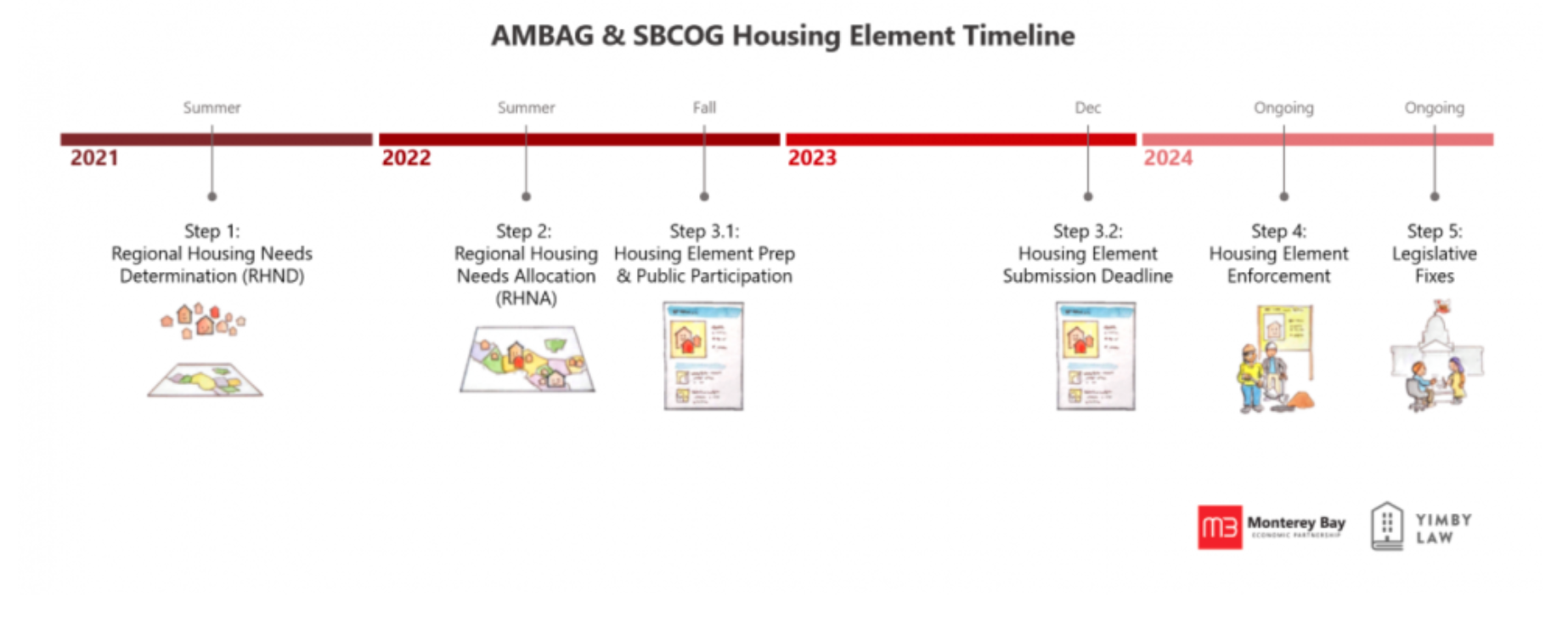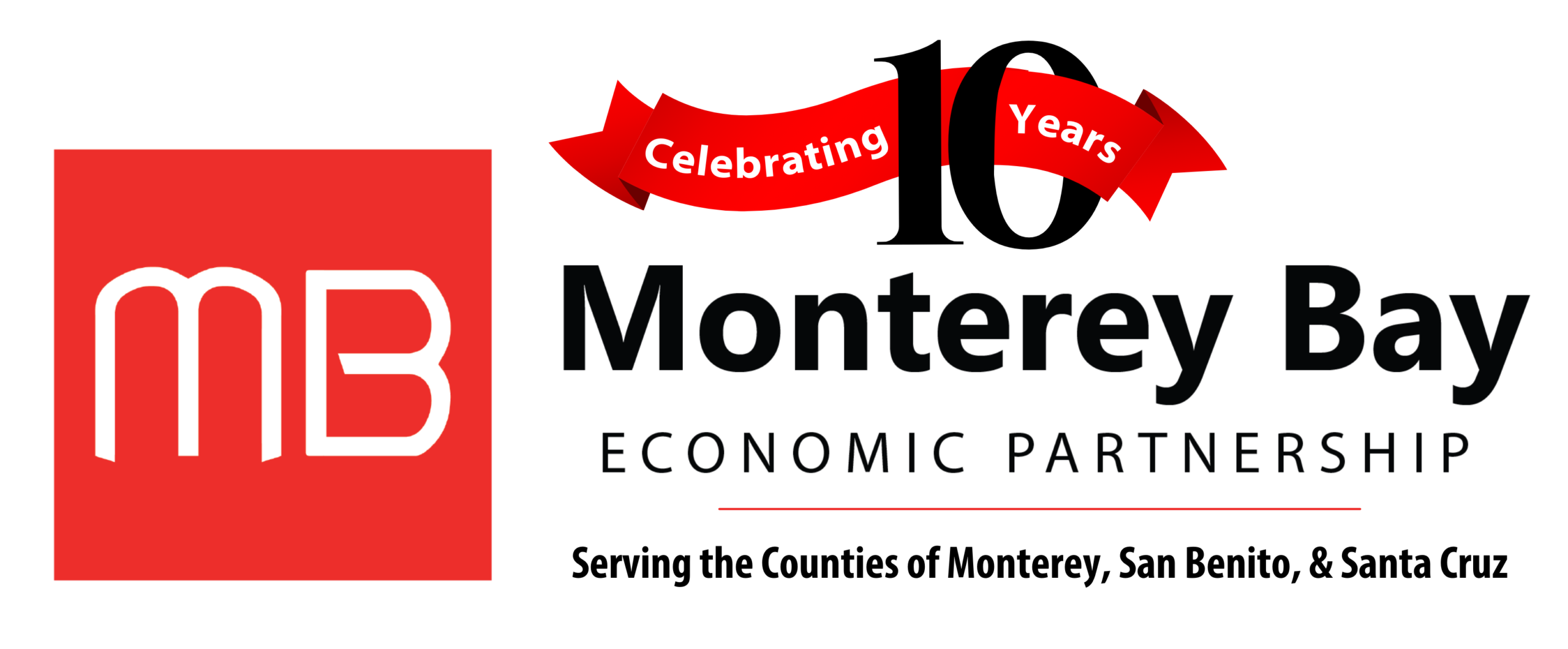HOUSING ELEMENTS
What is a Housing Element?
ACRONYMS
ADU: Accessory Dwelling Unit
AFFH: Affirmatively Furthering Fair Housing
AMBAG: Association of Monterey Bay Area Governments
COG: Council of Government
DOF: California Department of Finance
GP: General Plan
HCD: California Department of Housing and Community Development
HE: Housing Element
RHNA: Regional Housing Need Allocation
RHND: Regional Housing Need Determination
SBCOG: San Benito Council of Government
Frequently Asked Questions
What is a Housing Element?
The Housing Element is a state-required document that is part of a jurisdiction’s General Plan. It establishes housing needs and objectives and sets clear goals that are the foundation for the jurisdiction’s housing strategy. The Housing Element contains policies and programs to address items such as:
- Maintaining and improving current housing
- Providing adequate housing sites
- Aiding in the provision of affordable housing
- Eliminating constraints to housing development
- Promoting fair housing opportunities
- Zoning policy changes
In the latest Housing Element cycle, jurisdictions are now required to Affirmatively Further Fair Housing to expand social and economic opportunities. An expanded “No Net Loss” statute was also introduced requiring adequate sites to be maintained to accommodate unmet RHNA targets by each income category at all times.Housing Elements are critical for jurisdictions to be able to show how they plan to meet local housing needs. HCD determines the number of new homes that a jurisdiction needs to build and at what levels of affordability in order to meet these needs. This process is called the Regional Housing Needs Allocation (RHNA). Developers and jurisdictions receive state funding to build housing, and receipt of funds is often contingent on compliance with the Housing Element process. Consider referencing HCD’s Housing Element page for a comprehensive guide, tools, and resources. HCD recently released a checklist to help jurisdictions through the Housing Element process.
How is the Regional Housing Need Allocation (RHNA) determined?
The State of California requires that the RHNA target be determined based on the existing and future housing needs of the region. DOF and HCD forecast the need for housing within each region based on population projections. Other factors that are incorporated into the RHNA calculation include the share of households living in overcrowded conditions and the share of households that are rent- or mortgage-burdened. AMBAG prepares the Regional Housing Need Assessment (RHNA) plan for Monterey and Santa Cruz Counties. You can review their current plan here. San Benito County’s RHNA is prepared by the Council of San Benito County Governments (SBCOG).
What are the consequences if a city does not complete or meet the goals of its Housing Element or RHNA target?
Cities are required to submit their Housing Elements to HCD every eight years. Cities that do not comply with this requirement may lose access to funding for housing development and transportation, and also risk being sued by the state Attorney General. Courts may also impose fines of up to $600,000 per month. Detailed information on noncompliance can be found on the HCD and Fair Housing Element websites.If cities do not meet their RHNA targets during their biyearly state progress checks, SB 35 will take effect. Enacted in 2017, this law encourages cities to increase affordable housing on their own terms or else be forced to accept development proposals as mandated by the state. If a proposal meets a series of mandates outlined in Section 3.10, cities must approve the project within 60 days if the development contains less than 150 housing units, or 90 days if it contains more than 150 units.
How is it determined where new housing could be built, and what happens when suitable land runs out?
The Housing Element must identify specific sites available for housing development. Government Code Section 65583(a)(3) requires local governments to prepare what is known as an inventory of land suitable for residential development. Per HCD, “land suitable for residential development must be appropriate and available for residential use in the planning period. Identified sites that require rezoning may be included in the inventory, provided the housing element includes a program to accomplish the rezoning early within the planning period.”Hence, jurisdictions must accommodate the RHNA in their Housing Element. There are a number of options for communities with little vacant land, outlined below:
The Housing Element may evaluate existing developed properties as “underutilized sites”. Such properties may be available for intensification, or they may be non-residential sites with potential for re-designation and redevelopment for housing or mixed-use development. Examples of land with potential for recycling may include:
- Fragmented sites suitable for assembly
- Publicly owned surplus land
- Areas with mixed-use potential
- Properties facing substantial functional obsolescence
- Blighted areas with abandoned or vacant buildings
[ADUs] also provide a means of accommodating additional housing in built-out communities. Under limited circumstances, a portion of the City’s RHNA may be met through:
- Conversion of existing market-rate apartments to affordable levels
- Preservation of affordable units at risk of conversion to market rate
- Substantial rehabilitation of substandard apartment units combined with long term affordability covenants
If cities do not meet their RHNA targets during their biyearly state progress checks, SB 35 will take effect. Enacted in 2017, this law encourages cities to increase affordable housing on their own terms or else be forced to accept development proposals as mandated by the state. If a proposal meets a series of mandates outlined in Section 3.10, cities must approve the project within 60 days if the development contains less than 150 housing units, or 90 days if it contains more than 150 units.
What is the role of accessory dwelling units (ADUs) in the Housing Element process?
ADUs are integral and do count towards meeting the target figures set forth in the RHNA. However, quantifiable measures are needed to indicate that an ADU is suitable for lower-income households. While ADUs are small, the city needs to be able to prove that they can be counted towards the affordable allocation. Five key pieces of legislation on ADUs were signed into law in 2019, with AB 671 explicitly requiring Housing Elements to incentivize and promote affordable ADUs. United Way of Monterey County (UWMC) is focusing on ADUs as a means to increase the amount of affordable housing in the region. UWMC formed an advisory group that includes MBEP, Habitat for Humanity Monterey Bay, County of Monterey, City of Salinas, Community Housing Improvements Systems and Planning Association Inc (CHISPA), Monterey County Housing Authority Development Corporation (HDC), Rehabilitation Restoration Respite (R3), City of Seaside, and community volunteers. Click here for resources and to learn more about their work.
What is the relationship between climate change and the Housing Element process?
Government Code Section 65583(a)(7) requires “an assessment of housing needs and inventory of resources and constraints relevant to the meeting of these needs. The assessment and inventory shall include the following: An analysis of opportunities for energy conservation with respect to residential development.”While the Housing Element itself does not have a specific climate mandate, they can be – and often are – crafted with an eye towards sustainability. In our region, for example, cities may explicitly prioritize water allocation and work with water management districts to minimize water use. Additionally, there is a statewide effort to prioritize infill housing in wildfire-prone jurisdictions. However, up-zoning away from wildfire areas is not statutory, and we are working towards legislative action on this issue. Transportation is another way in which the Housing Element process interacts with climate change. Significant effort goes into creating affordable options that allow residents to commute via foot, bike, or public transport, all of which contribute to lower greenhouse gas emissions. United Way of Monterey County (UWMC) is focusing on ADUs as a means to increase the amount of affordable housing in the region. UWMC formed an advisory group that includes MBEP, Habitat for Humanity Monterey Bay, County of Monterey, City of Salinas, Community Housing Improvements Systems and Planning Association Inc (CHISPA), Monterey County Housing Authority Development Corporation (HDC), Rehabilitation Restoration Respite (R3), City of Seaside, and community volunteers. Click here for resources and to learn more about their work.
How does the Housing Element process incorporate diversity, equity, and inclusion?
Housing is rooted in a long history of racist practices, particularly as it pertains to zoning. Government policies at all levels both implicitly and explicitly excluded people of color from living in certain neighborhoods and being able to own homes. These practices have kept communities racially and economically segregated, and the Housing Element is one of the ways to help reverse this pattern. By law, Housing Elements are required to plan for inclusion by AFFH. Cities must actively encourage more integrated, inclusive communities in the Housing Element, which includes planning for affordable housing in high-opportunity neighborhoods. Rezoning areas that have traditionally been reserved for individual households is one way that Housing Elements can address this issue.
How can I get involved?
The Housing Element encourages public participation throughout the process. Cities will often release surveys to provide the opportunity for community engagement and understand which issues are most important. You can refer to your city’s housing website for specific information.For housing advocacy more broadly, reach out to your local housing advocate or fair housing chapter for volunteer opportunities. Two great advocacy groups in our region are YIMBY Law and the Campaign for Fair Housing Elements. You can also check for updates at our Action Center. If you do not have these types of groups in your region, you can connect with local allies, such as organizations supporting foster youth and our unhoused neighbors, to build a coalition. You can also connect with your local Planning Department for opportunities to get involved on task forces.
What qualifies as affordable housing?
Housing affordability is based on the standard of spending no more than 30 percent of gross household income on housing costs, which includes utility payments, taxes, insurance, and homeowner association fees, among others. Below market-rate housing is made available through government subsidies and social programs, such as housing vouchers.In the context of the Housing Element, affordable housing is broken down into housing intended for extremely low, very low, and low-income households, while sometimes addressing housing for households above moderate-income levels.Affordability is relative to the size, income level, and location of the household. As an example, Monterey City provides its annual income limits on its Housing page here. You can check the Planning Department website of your city to find the income limits for different household sizes.
How long do Housing Elements take to complete?
There are 5 key steps to completing the Housing Element. The first three steps are to complete the RHND, complete the RHNA, and submit the Housing Element to HCD. These steps have firm timelines and take approximately two and a half years to complete. Steps four and five are ongoing processes to enforce the Housing Element and make legislative changes. AMBAG & HCD’s timeline can be observed below:

